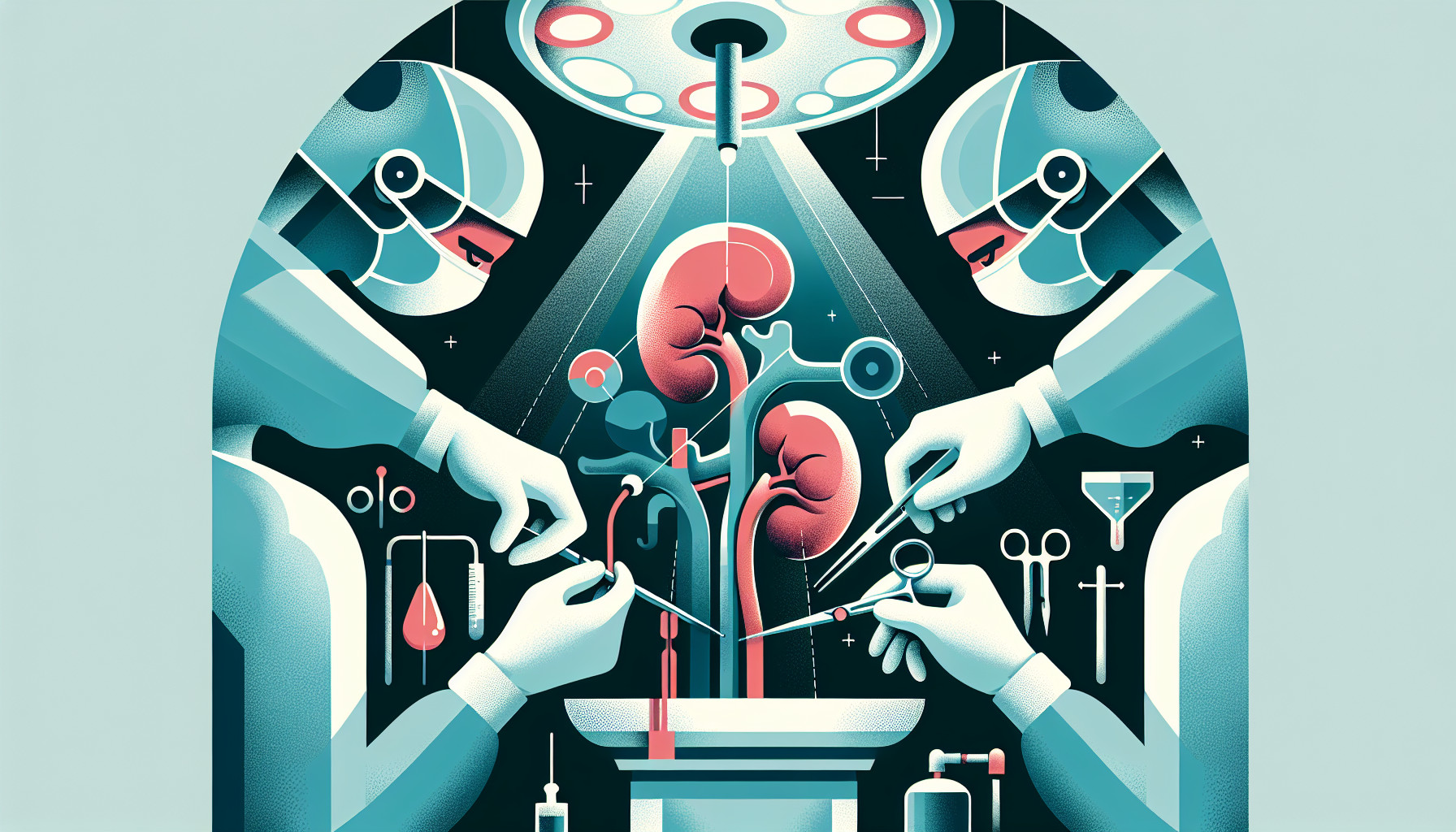Our Summary
This research paper is about comparing two types of surgeries used to remove a kidney from a living donor for a kidney transplant. The two types are laparoscopic donor nephrectomy (LDN) which is less invasive, and open donor nephrectomy (ODN) which is the traditional way.
The study looked back at all the kidney removal surgeries from living donors that took place at Hospital Universitario La Paz between 2004 and 2014. They compared various things, like the donors’ age, how long the surgery took, any complications after the surgery, how long the donors stayed in the hospital, and how well the kidney functioned after 6, 12, and 18 months.
The results showed that there were 114 surgeries in total, 85 were LDN and 29 were ODN. The donors’ ages and medical backgrounds were similar, except the average age was a bit higher for the ODN group. LDN was used mostly for left kidneys and ODN for right kidneys. The average surgery time was a bit shorter for the LDN group but not by much. The time the kidney spent without blood flow was slightly less in the ODN group. There was no significant difference in complications after surgery between the two groups. No one had to be readmitted to the hospital. The hospital stay was a bit shorter for the LDN group but again, not by much. The working of the kidneys, measured by creatinine levels in the blood, did not differ over time.
The conclusion is that both types of surgeries had similar results and the kidney function was not compromised in either of them. The LDN, being less invasive, did not lead to an increased rate of complications, proving that it can be performed safely by experienced surgeons.
FAQs
- What are the two types of surgeries used to remove a kidney from a living donor?
- Was there a significant difference in complications after surgery between laparoscopic donor nephrectomy (LDN) and open donor nephrectomy (ODN)?
- Did the type of surgery performed affect the functioning of the kidneys after 6, 12, and 18 months?
Doctor’s Tip
One helpful tip a doctor might tell a patient about laparoscopic nephrectomy is to carefully follow all post-operative instructions, including taking any prescribed medications, getting plenty of rest, and avoiding strenuous activities until cleared by the doctor. It is important to attend all follow-up appointments to ensure proper healing and kidney function. Additionally, maintaining a healthy lifestyle with regular exercise and a balanced diet can help support overall kidney health post-surgery.
Suitable For
Patients who are typically recommended for laparoscopic nephrectomy are those who are in need of a kidney transplant and have a living donor willing to donate a kidney. This surgery is especially beneficial for donors who are looking for a less invasive procedure with shorter recovery time. Additionally, patients who are in good health and do not have any major medical conditions that may complicate the surgery are good candidates for laparoscopic nephrectomy. It is important for patients to discuss their options with their healthcare provider to determine the best course of action for their specific situation.
Timeline
Before laparoscopic nephrectomy, a patient may undergo various tests and consultations to determine if they are a suitable candidate for the surgery. They will also receive pre-operative instructions and may need to follow a specific diet or medication regimen.
During the surgery, the patient is placed under general anesthesia and small incisions are made in the abdomen for the laparoscopic instruments. The surgeon uses a camera to guide the instruments and remove the kidney, which is then extracted through one of the incisions.
After the surgery, the patient will spend some time in the recovery room before being transferred to a hospital room. They will be monitored for any complications and given pain medication as needed. The patient will gradually resume normal activities, following post-operative instructions from their healthcare team.
Overall, the recovery time for laparoscopic nephrectomy is shorter compared to open donor nephrectomy, with most patients able to return to normal activities within a few weeks. The long-term outcomes, such as kidney function, are comparable between the two types of surgery.
What to Ask Your Doctor
Some questions a patient should ask their doctor about laparoscopic nephrectomy include:
- What are the potential risks and complications associated with laparoscopic nephrectomy compared to open donor nephrectomy?
- How experienced is the surgical team in performing laparoscopic nephrectomy?
- What is the expected recovery time and post-operative care after laparoscopic nephrectomy?
- How long will I need to stay in the hospital after the surgery?
- Will there be any long-term effects on kidney function after undergoing laparoscopic nephrectomy?
- Are there any specific criteria that make a patient a better candidate for laparoscopic nephrectomy over open donor nephrectomy?
- What are the success rates of laparoscopic nephrectomy compared to open donor nephrectomy in terms of transplant outcomes?
- Are there any lifestyle changes or restrictions I should be aware of after undergoing laparoscopic nephrectomy?
- How often will I need to follow up with my healthcare provider after the surgery?
- Are there any alternative treatment options to consider before proceeding with laparoscopic nephrectomy?
Reference
Authors: Carrión DM, Gómez Rivas J, Aguilera Bazán A, Alonso Y Gregorio S, De Castro Guerín C, Álvarez-Maestro M, Díez Sebastián J, Aguilar A, Jimenez C, Gómez Tabernero Á, Cansino R, Alonso Dorrego JM, Martínez-Piñeiro L. Journal: Arch Esp Urol. 2019 Jun;72(5):508-514. PMID: 31223128
